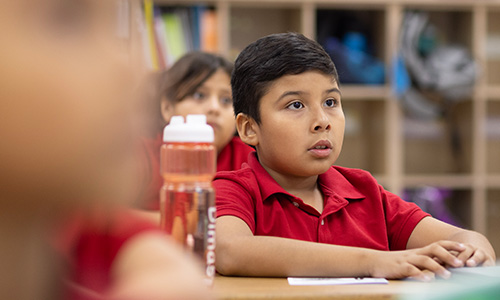
We throw a pretty amazing conference every year called Fusion. Fusion is a chance for educators from around the country to get together to learn about and share evidence-based practices for moving students forward. And every year, we have multiple workshops about goal setting. Why? Because goal setting for students is absolutely an evidence-based best practice for improving student outcomes.
Fusion sessions are often packed as educators from large and small, urban and rural districts learn about goal setting. Below you’ll find some important goal setting questions that come up every year, along with the answers.
What is goal setting for students?
Goal setting is a set of practices for helping individual students understand their academic performance, identify concrete goals for future performance, and collaborate with their teacher on the behaviors and practices that will get them there.
Why is goal setting for students so important?
There are many benefits to both the process and the outcomes of goal setting. Here are a few of the most important ones:
- Students get motivated. Research shows that goal setting is implicit. As soon as a task is introduced, students are already planning on how much effort they are going to put in. Setting goals helps students stay motivated and engaged by giving them clear targets to aim for.
- Students take ownership. When students set their own goals, they own their goals and their learning. This sense of control and autonomy has many benefits, including increased self-confidence.
- Students continuously improve through formative assessment. Goal setting works hand-in-hand with formative assessment. Teachers can use goals to guide their instructional strategies and provide targeted feedback, helping students continuously improve.
- Students see their own growth. Goals provide a framework for measuring progress. By setting and achieving goals, students can see their growth over time, which reinforces their learning and development.
What are effective student goal setting strategies?
In what is surely going to be welcome news to busy teachers, the goal-setting process doesn’t require following strict rules. Effective strategies generally share five key ideas:
- Center student choice.Students should feel like they are in charge of what and how they learn. Centering their choices provides the opportunities for self-reflection and agency that are critical for empowering learners. This is an important idea to incorporate as you’re working with your students on goals.
- Start early.Students can begin setting individual behavioral or academic goals as early as kindergarten! Getting this early start helps students get used to the process. It’s equally important to set goals as early as you can every school year.
- Do it often. Individual goals should be short-term, spanning around four to six weeks. Regular weekly check-ins with students are great for evaluating progress, making adjustments, encouraging students, and helping kids stay focused if they are feeling discouraged.
- Make it visual. Effective goal-setting techniques involve tools like anchor charts, data walls, personalized learning plans, data notebooks, and other student-accessible resources. These ask students to directly identify their goal, describe the steps they should take to get there, and ultimately provide evidence their goal has been reached.
- Create personal relevance.The best goal-setting processes begin during conversations with students about what matters to them. Teachers can use students’ personal aspirations, areas of interest, or experiences as departure points for talking about why setting a goal matters.
What’s the role of assessment data in goal setting for students?
Assessment data plays a crucial role in goal setting. Accurate assessment data provides the insights that establish where a student is in their learning. It also helps you tailor educational strategies to the student’s individual needs.
How can I set effective goals using MAP Growth data?
Goal setting is an area where MAP® Growth™ really shines, primarily because the growth norms are created from the world’s largest pool of student data. Here’s a quick example of what goal setting with MAP Growth can look like.
Step 1: Analyze your assessment data
Start here! Always get underway by assessing what a student already knows. This is the departure point for helping students make their own next steps and connect with their own growth.
Step 2: Have a conversation
The most important part of goal setting is ensuring students set goals that are meaningful and realistic for them. If goals are created and simply given to a student, the student won’t be invested in the goal. It’s also crucial that the goal centers on the relevant learning that needs to occur, not just on the increase of a number, like a RIT score. The MAP Growth Student Profile report is a great starting point for this conversation.
Here are some recommendations on how to talk things over with a student:
- Talk with your student about how they felt when they took the assessment. What did they feel comfortable with? What was challenging? For example, they might say that they felt pretty good about questions related to whole numbers and basic operations but weren’t as sure about the fraction questions.
- Look at the goal section of the report with your student. What would be average growth for similar students? Depending on your student’s current achievement percentile, meeting the average growth might be adequate. If they are at the 85th percentile, meeting the growth projection would keep them at roughly that achievement level. If they are below the 50th percentile, above average growth might be needed. A reasonable growth percentile would be at the 60th percentile of growth. This gives a goal for the next MAP Growth assessment, and you’ll need a plan to reach this goal. Focus on the Instructional Areas section of the Student Profile report to determine specifically what learning would help you reach the goal.
- Look at the learning statements. These will provide an idea of the types of questions your student will be able to answer correctly about half the time, or those in their zone of proximal development. Talk with your student about how this data relates to how they feel about their learning and determine a concept and skills that they would like to focus as you’re going through your next unit.
- Have your student write the goal. Having students write their own goals gives them a sense of ownership. After that, they can determine the steps they can take to meet them, and you can identify how you can support them. It’s also helpful to think about what might get in the way of reaching a goal as well as what can be done to overcome barriers.
What should I do between MAP Growth testing events?
Your students will take MAP Growth three times a year: in the fall, winter, and spring. Between those testing events, it’s helpful to track progress with formative assessment. One of the greatest benefits of formative assessment is that it can help you identify progress toward a goal and course correct if necessary. Just remember: formative assessment should never be used for grading.
You can also strengthen the school-to-home connection by sharing student goals with the student’s family and caregivers with the Family report. Feel free to also share the Family Toolkit, which is loaded with helpful resources.
Finally, be sure to celebrate accomplishments along the way. Encouraging students to be proud of what they’ve achieved can help them stay the course and feel excited and confident about their learning.
Thinking ahead
Goal setting for students, like everything else, is about preparing the young people in your class for the future. It’s such an amazing, effective best practice for them today and a practical skill they can use once they have finished school and are out changing the world. By starting with students early, you’re giving them an essential tool to use right now and a great head start in life.
For more ideas on how to tackle goal setting in your classroom, read more here in Teach. Learn. Grow. and watch the video below.






